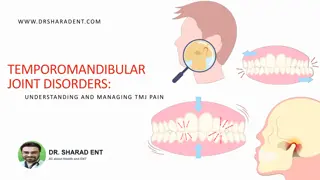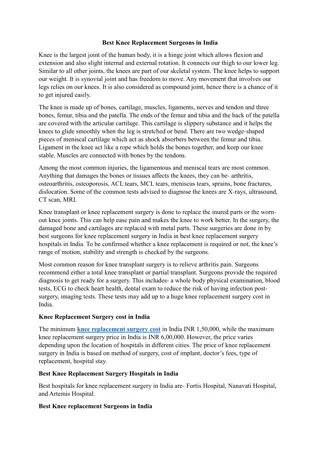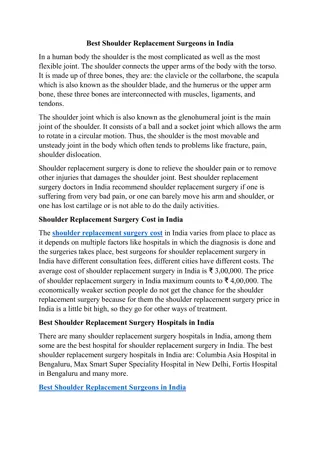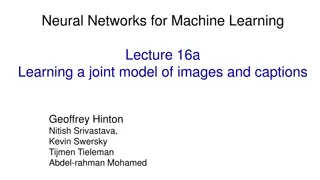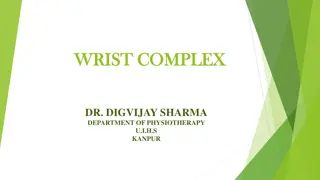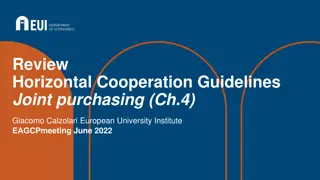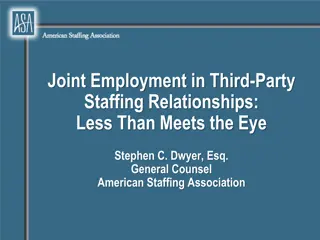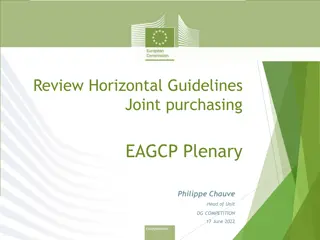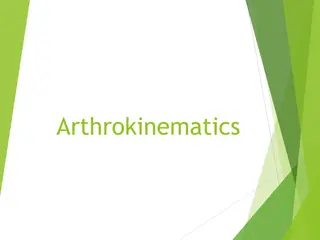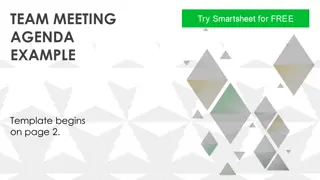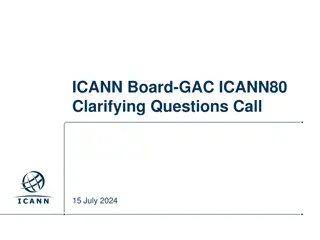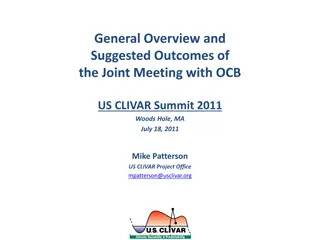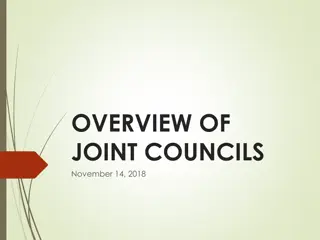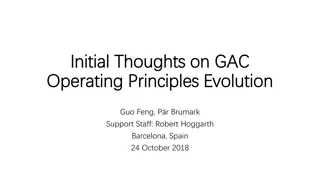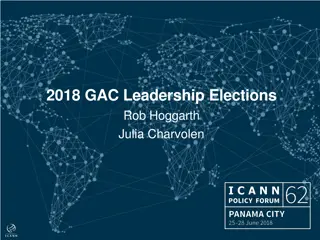
Joint GAC-GNSO Meeting Agenda
This meeting agenda outlines various topics to be discussed, such as status updates on GNSO PDPs, exchange of views on recommendations, activities of GAC-GNSO Consultation Group, and more. The agenda includes welcome and introductions, updates on specific PDPs of interest to GAC, and the New gTLD Subsequent Procedures Policy Development Process timeline.
Download Presentation

Please find below an Image/Link to download the presentation.
The content on the website is provided AS IS for your information and personal use only. It may not be sold, licensed, or shared on other websites without obtaining consent from the author. If you encounter any issues during the download, it is possible that the publisher has removed the file from their server.
You are allowed to download the files provided on this website for personal or commercial use, subject to the condition that they are used lawfully. All files are the property of their respective owners.
The content on the website is provided AS IS for your information and personal use only. It may not be sold, licensed, or shared on other websites without obtaining consent from the author.
E N D
Presentation Transcript
Joint GAC GNSO Meeting Wednesday 29 June 9.30 10.30
Agenda 2 3 1 Status update & discussion on GNSO PDPs of specific interest to the GAC Exchange of views on next steps in relation to outstanding Red Cross / IGO recommendations Welcome & Introductions 4 5 6 Status update on activities of GAC- GNSO Consultation Group and expected next steps Operation of the Empowered Community discussion of preparations AOB | 3
2. Status Update & discussion on GNSO PDPs of specific interest to the GAC
Current PDPs Thick WHOIS Translation & Transliteration IRTP Part C & D Protection of International Organization Names in all gTLDs (adopted recommendations New gTLD Subsequent Procedures IGO/INGO Curative Rights Next Generation Registration Directory Services to Replace WHOIS Review of all Rights Protection Mechanisms in all gTLDS Privacy & Proxy Accreditation Services Issues Protection of International Organization Names in All gTLDs (outstanding recommendations) | 6
PDPs of specific interest to the GAC new gTLD Subsequent Procedures TLDs in Emerging Regions (GAC identified sub-topic) Geographical and Culturally Significant Names (GAC Identified sub-topic) IGO/INGO Curative Rights Further information and details on these and other policy development efforts can be found in the GNSO Policy Briefing: http://gnso.icann.org/en/issues/background-briefing-20jun16-en.pdf | 7
New gTLD Subsequent Procedures Policy Development Process
Timeline: Path to the Current PDP on New gTLD Subsequent Procedures 1 Jun 2015 24 Jun 2015 31 Aug 2015 17 Dec 201521 Jan 2016 22 Feb 2016 Preliminary recommendations End of 2017? Working Group starts weekly meetings GNSO Discussion Group submits report to GNSO Council GNSO Council requests Preliminary Issue Report GNSO Council approves Charter for the Working Group GNSO Council initiates PDP Preliminary Issue Report published for public comment Notes: Discussion Group (DG) developed an Issue Matrix (based on experiences from the 2012 New gTLD Program round) and mapped the issues to the original 2007 GNSO Policy Principles, Recommendations & Implementation Guidance DG also developed a draft Charter with suggested groupings for the issues, with potential questions for each issue intended as starting point for the eventual PDP and basis of the Staff Issue Report | 9
What is the Purpose of the New gTLD Subsequent Procedures PDP? PDP will determine what, if any, changes may need to be made to the existing Introduction of New Generic Top-Level Domains policy recommendations from 2007 Original policy recommendations as adopted by the GNSO Council and ICANN Board were designed to produce a systemized and ongoing mechanisms for applicants to propose new top-level domains They will remain in place for subsequent application processes unless the GNSO Council adopts changes as a result of this PDP Potential changes may include: Clarifying, amending or overriding existing policy principles, recommendations, and implementation guidance; Developing new policy recommendations; Supplementing or developing new implementation guidance | 10
Status of work and the methodology adopted by the PDP Working Group What is the WG currently working on? A total of 38 subjects in the WG s charter and 6 have been identified as high-level, overarching subjects. Preliminary discussions have taken place and community input has been sought on these subjects 1 When will the other 32 subjects be addressed? WG expects to divide into a series of sub teams to conduct preliminary discussions and again, seek community input on the remaining subjects 2 How will the WG conduct its work? WG will conduct preliminary discussions, seek input from community, integrate work from other efforts, and only then will it reach conclusions 3 | 11
What are the other concurrent efforts that may impact this PDP? Competition, Consumer Trust & Consumer Choice Review Team CWG on Use of Country and Territory Names GNSO PDP on Review of All RPMs in all gTLDs Completion of work on protection for IGO-INGO names and acronyms Work in the GAC, ALAC, SSAC, etc. | 12
How will concurrent efforts affect the PDP? For example CCT-RT The PDP WG may delay consideration and development of policy recommendations until data, analysis, and recommendations on topics of high interest to the RT are complete 1 Geographic Names and Culturally Significant Names Receiving feedback from CWG-UCTN, for instance, could lead to policy development, possibly as part of New gTLD Subsequent Procedures 2 IGO/INGO Will need to account and integrate Board approved recommendations/implementation related to Reserved Names and TLD startup (claims notifications) 3 | 13
What is the status of this PDP? About this PDP Status of work Preliminary conclusions will focus on IGOs (not INGOs) Possible standing to file may be based on Article 6ter of the Paris Convention (note that this should not create additional legal rights) External legal expert has provided opinion on state of international law on IGO jurisdictional immunity WG chartered by GNSO Council to examine: Whether existing curative rights processes the Uniform Dispute Resolution Policy and the Uniform Rapid Suspension dispute resolution procedure should be modified to address the specific needs of International Governmental Organizations (IGOs) and International Non-Governmental Organizations (INGOs), and if so, how; or Whether a new, narrow procedure is needed Background information GNSO webpage with Issue Report, WG Charter & Council resolutions: http://gnso.icann.org/en/group- activities/active/igo-ingo-crp-access WG online collaborative wiki with recordings and transcripts of all meetings and draft documents: https://community.icann.org/x/37rhAg | 15
2. Does agreement to Mutual Jurisdiction mean the IGO has waived any immunity to which it may be entitled? If so, what are the policy options? Legal expert conclusion: IGOs generally enjoy immunity under international law, but different jurisdictions apply the law differently, and even within the same jurisdiction different IGOs may be treated differently: Immunity obligations vary by state and by IGO concerned Immunity decisions are often based on organization-specific treaties to which not all states are party States subject to the same international obligations may implement them in varying ways Every jurisdiction resolves immunity questions according to its own law (the law of the forum , as informed by international law) Allowing an IGO that prevailed in the UDRP process to avoid its waiver and rest on the UDRP result by invoking immunity, while allowing it to waive that immunity by initiating judicial proceedings if it loses to a domain-name registrant, will likely seem asymmetrical and unfair. Policy options under discussion: Retain status quo (no change) Consider non-judicial process (arbitration?), possibly with safeguards to alleviate possible hardship on legitimate registrants Rewrite Mutual Jurisdiction clause without prejudging immunity Make distinction between different types of IGOs | 16
3. Exchange of views on next steps in relation to outstanding Red Cross / IGO recommendations
4. Status update on activities of GAC-GNSO Consultation Group and expected next steps
Current Status Joint GNSO GAC initiative - Explore and enhance ways of early engagement of the GAC in relation to GNSO policy development activities. Work divided into two tracks: Day-to-day ongoing co-ordination GAC Early engagement in GNSO PDP Deliverables to date: GNSO Liaison to the GAC Permanent role Implementation of PDP Issue Scoping recommendations as a pilot ( Quick Look Mechanism ) Monthly PDP one-pagers highlighting next engagement opportunity Joint GAC-GNSO Leadership calls prior to ICANN meetings to prepare (this) joint session and discuss any items of common interest | 19
GAC-GNSO CG Survey Objective Obtain input on the experiences to date with the Quick Look Mechanism as well as additional suggestions and ideas for opportunities for early engagement in the other phases of the PDP 1 Participation 30 responses; 13 GAC & 17 GNSO However, many questions skipped by majority of respondents 2 QLM Over 60% of respondents to that answered that question agree that the QLM has positively contributed to the early engagement of the GAC in the GNSO Policy Development Process 3 Additional Stages of PDP Some support to explore additional engagement opportunities in other phases of PDP 4 Next Steps CG to review survey results (see https://www.surveymonkey.com/results/SM- 6ZLVM39T/) and determine next steps. 5 | 20
Next Steps CG to reconvene post Helsinki to discuss next steps Objective to complete work by ICANN57 and present final results to GNSO and GAC Expectation that ATRT3 will review improvements and assess effectiveness | 21
5. Operation of the Empowered Community discussion of preparations
Tell us what you think of the Policy Meeting Format. Download the ICANN56 Mobile App and complete a short survey. meetingapp.icann.org

